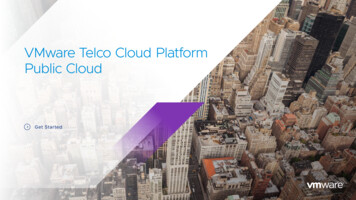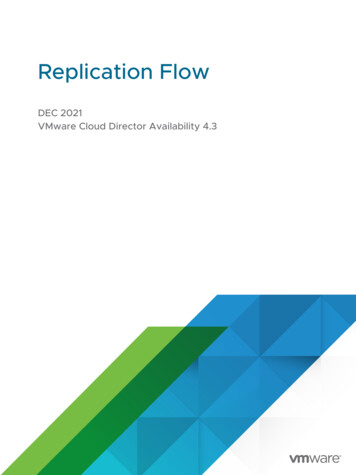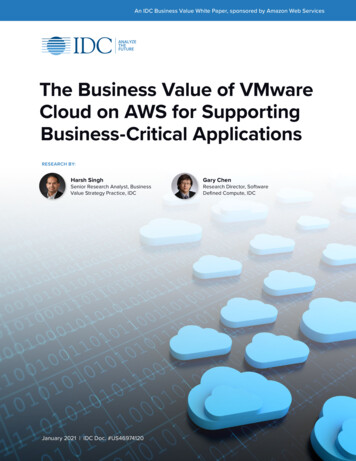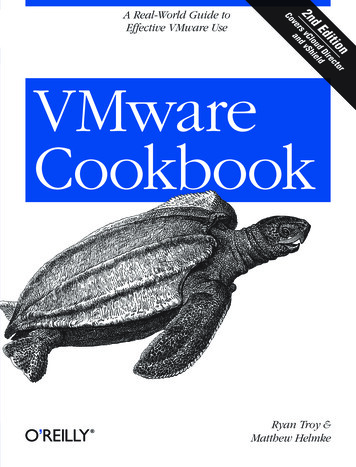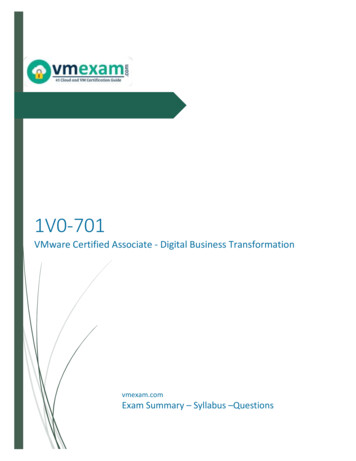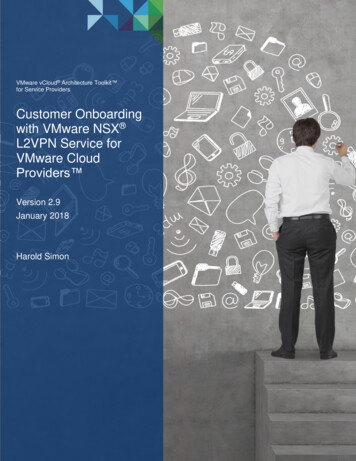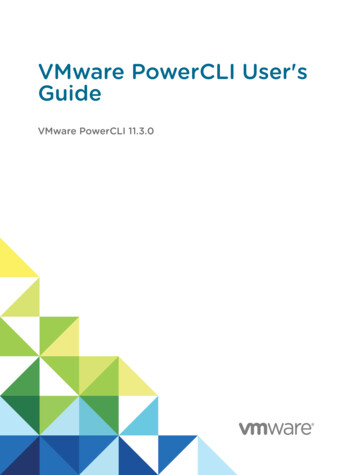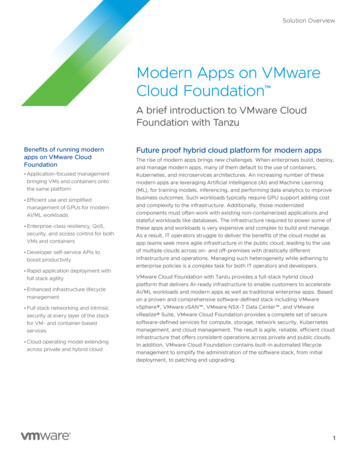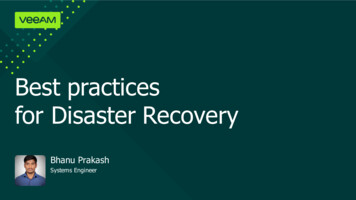
Transcription
NAME OF THE PROJECTComparison ofVMware CloudOptionsSponsored by Oracle Cloud InfrastructureAuthors:Matt Leib – Contributing Analyst, The CTO Advisor LLCKeith Townsend – Principal, The CTO Advisor LLC
“Customers now have anumber of viable VMwaresolutions in the public cloud.Each is differentiated tomeet the requirements oftypical customers and usecases for that cloudprovider.”– CTO Advisor The CTO Advisorwww.thectoadvisor.com
Executive SummaryAccording to this report’s authors, hybrid infrastructure is an operating model, not a place.(Townsend, 2019) Regardless of the use case, enterprise IT organizations find the need to runtraditional workloads alongside the modernized application stack. Decision makers arechallenged with gaining the operational experience needed to deploy and manage modernapplications while maintaining the traditional application landscape.VMware’s vSphere hypervisor remains the primary choice for IT teams that want to deliverhigh-performing and resilient infrastructure. While organizations have de-emphasized the needfor privately owned data centers, the demand for vSphere-managed workloads remainconsistent. According to Synergy Research Group (Synergy Research Group, 2020), private dataspending has remained solid over the past 10 years. At the same time, the study shows growthin public cloud spending growing from 0 to 100B over the same time period. As a result, eachof the major cloud providers have introduced a cloud-based VMware vSphere offering.Here are the key findings of the research and testing of the CTO Advisor team: Each solution is representative of the individual cloud provider’s approach to hybridinfrastructure and application modernization. The staff’s learning curve to deploy and manage each solution varies widely and is highlydependent on the operations team’s knowledge of the target cloud control plane. The bare-metal configuration for each solution varies and may dramatically impactworkload cost between cloud solutions. The cloud provider’s network design will have significant effects on the level ofintegration with native cloud services. Due to the differences in cloud control planes and vSphere implementation details,managing vSphere across more than one cloud provider via a single operations teammay prove a difficult endeavor.There’s not a winner-takes-all result with these solutions. Each of the three solutions weevaluated is viable, but fall into two broad strategies. One approach is to give full control –Oracle succeeds here by most closely replicating an on-premises VMware environment,enabling full transfer of skills, tools, and experience. The second approach is a “SaaS-like”experience – AWS and Google succeed here by layering on more automation and abstractingthe infrastructure. Regardless of your cloud vendor preference, you’ll find this reportinformative in understanding the opportunities and hurdles in adopting vSphere in the publiccloud. The CTO Advisorwww.thectoadvisor.com
Comparision of VMware Cloud OptionsReportOverviewAs organizations tackle the challenge of modernizing their applicationlandscape to take advantage of the public cloud, executives arechallenged to provide a smooth transition. Lift and shift of the existingVMware landscape into the public cloud provides an eased transitionfrom on-premises operations to public cloud operations.This report focuses on hands-on operational testing of a real-worldissue for many organizations: to expand their environments into thecloud with as little transformation of methodology as possible. Thescenario we examine is a common one; a virtual desktop infrastructure(VDI) environment, already in place, that must be extended to thecloud and run consitently as it has been. To reduce risk, therequirement is to maintain the performance, operation, andmanagement of the native environment as closely as possible, with aslittle modification as possible to expand, extend, or even enhance theoperations. Our testing environment used VMware Horizon, one of theleading VDI solutions on the market today.There are a number of approaches to running a VMware-based Horizonenvironment on the various public cloud architectures. The purpose ofthis project is to illustrate the pitfalls, the successes, the variances inapproaches, and the ultimate outcome of such a project. Comparisonof proven solutions takes an approach that everything will ultimatelywork. However, getting there and doing the work necessary to provethis out is not something all customers have the bandwidth to perform.“For the purposes of this report, The CTO Advisor staff adopts thepersona and activities of an IT team tasked with performing thesemigrations and testing the outcomes.Lift and shift of theexisting VMwarelandscape into thepublic cloud providesan eased transition-Keith Townsend The CTO Advisorwww.thectoadvisor.com
Comparison of VMware Cloud OptionsVendor LandscapeVMware has long held the lion’s share of the virtualization market. As of 2017, VMwarecaptured over 80% of the hypervisor market (Chen, 2018). The concept of running true nativeVMware on cloud-based platforms, however, has presented a challenge. While manyapproaches have been tried, the concept has long been seen as the brass ring. Otherapproaches to stand up separate data center spaces within Azure, AWS, and Google Cloud haveexisted since the inception of these solutions, but operations teams have struggled to adopt anative cloud approach to running existing workloads.In this study, we began by defining the players, specifically: AWS, Google Cloud Platform,Microsoft Azure, and Oracle Cloud Infrastructure. During evaluation, the Azure solutionchanged models quite dramatically, as Microsoft removed the model based on CloudSimple. Bydoing away with new implementations on the CloudSimple model, we determined that theAzure SDDC (Software Defined Data Center) approach would not be viable. The new modelwould not be ready with an out-the-door solution in the timeline required. Thus, we chose toexclude Azure from this project’s testing list.Oracle Cloud Infrastructure VMware SolutionThe newest offering to be made into the extension of an on-premises data center into thecloud, Oracle’s Cloud Infrastructure (OCI) performs far more like a bare-metal implementationthan other solutions -- because that’s what it is. Oracle gives access to the underlying hardwareinclusive of the storage configuration. The model is so VMware-centric that it can be operatedby a savvy engineer experienced with VMware products -- without much additional knowledge.As long as the enhanced linked mode or “FastConnect” is in place, all additional operations,regardless of locale, will operate precisely as if the administrator’s environment is stretchedfrom the primary to a secondary data center.Oracle’s VMware solution follows the methodology of the parent Oracle Cloud Infrastructure.The concept of OCI is the ability to shift existing applications as they are into the data center.For example, OCI supports Layer 2 networking within a Virtual Cloud Network (VCN). Customerscan bring, without reconfiguration, an existing clustered application that leverages multicast toestablish clustering. The L2 connection today is limited to VMware-to-VMware stretch clusters.This particular component appears ripe for expansion.More valuable is the ability for Oracle to offer the solution in each of their regions, 19 regionsas of this writing, with no additional infrastructure or development. Oracle claims this tightintegration results in the VMware Solution looking like any other native cloud service offered byOracle Cloud Infrastructure. The CTO Advisorwww.thectoadvisor.com5
Comparison of VMware Cloud OptionsThe value of this solution is that there is a minimal learning curve. It’s a customer’s VMwareimplementation on top of Oracle’s hardware -- gated, secured, managed, and controlled byyour existing VMware staff, yet housed on OCI’s hardware. The flattened learning curve meansthe customer can be up and running as soon as the data pipe is in place. Wizards exist to buildthe SDDC implementation, the Horizon View architecture, and many other components of therequired VMware solution, practically out of the box.iSCSI and NFS StorageThe model is so emphaticallydifferent from the other cloudproviders that you may actually bringin storage of your own to an Oracledata center and attach that as well toyour VMware environment housed inan Oracle data center. Oracle doesn’tsupport this feature as of this report.However, The CTO Advisor testingteam set up an NFS share on aWindows machine and was able tomount it as a datastore. We’d advisecustomers to discuss this use casewith both Oracle and VMware. Oracleallows for a cross-connection viaFastConnect to be placed within thelocal Oracle point of presence, usingthat connection to mount it to OCI,then, using a replication, such asNetApp’s SnapMirror, to replicatethis storage from the on-premisesdata center to the OCVS.VMware Cloud on Amazon Web Services (VMC on AWS)Since its inception, Amazon Web Services (AWS), the most mature of all the major platforms,has had its own approach to the creation of virtual server platforms in the cloud. It’s grown inmany ways since the beginning and has been capable of creating a great deal of value for manyorganizations.VMware delivers VMC on AWS as part of its VMware Cloud suite of solutions. At the surface,this may seem like a technicality. Unlike the other solutions tested, however, VMC on AWS isn’tavailable via the product dashboard of the native cloud provider. A separate business andtechnical relationship is established with both VMware and AWS. The CTO Advisorwww.thectoadvisor.com6
Comparison of VMware Cloud OptionsVMware Cloud on AWS opens the opportunity for a customer to extend its existing VMwareinfrastructure to AWS, within certain parameters. VMC on AWS is delivered similarly to asoftware as a service (SaaS) offering. For example, VMware places guardrails around thevSphere experience to ensure the solution can be upgraded across multiple customers withoutcustomization of each customer’s experience. As such, there’s no access to the underlyinghardware platform via traditional vSphere tooling.With appropriate bandwidth and licensing, a customer may clone a set of servers on AWS, runthem on their infrastructure and achieve satisfactory results. Most of the functionality remainsthe same, but there are nuances in how it works. There are limits to the granularity of controland the visibility into the hardware an administrator has over hardware, and over theperformance of these hosts, thus the guests as well. VMware Cloud on AWS is a powerful steptoward extending the on-premises architecture onto AWS.Google Cloud VMware Engine (GVE)A key differentiator on the GVE lies in the quality of its wizards. Many wizards allow for clickingon a link, which will trigger the deployment of a fully qualified, hosted VMware-basedinfrastructure. Unlike the other tested solutions, GVE doesn’t support connecting the vCentersin Linked Mode.The solution is more of a hybrid of the OCI and VMC on AWS solutions. As mentioned, each ofthese solutions tend to align with the parent solution. Google’s focus is leveraging its networkand Kubernetes capabilities, and GVE exhibits many of these characteristics.Similar to VMC on AWS, the SDDC resides in a different VPC as the customer’s primary Googleaccount. This means networking is similar to AWS on VMC.During a briefing for the product, Google representatives said that while VMware’s NSX-T offerspowerful capabilities, such as cloud network overlays, customers would leverage Google’snative network capabilities for integration of hybrid and multi-cloud use cases. It’s not apparentwhich features would further enable the existing VMware software-defined network.Similar to native network capabilities, Google believes customers would leverage GoogleAnthos for the management of container instances in the SDDC vs. VMware’s Tanzu MissionControl. The CTO Advisorwww.thectoadvisor.com7
Comparison of VMware Cloud OptionsCommonUse CasesDisaster RecoveryDisaster recovery (DR) is one of the most common use cases for cloudbased vSphere deployments. By design, VMware workloads areencapsulated in a set of virtual disk images. Thus, VMware abstractsthe application and data from the infrastructure. The VMwareecosystem has a long history of DR support via storage replication.Traditional DR solutions required organizations to enact a DR site thatmade a substantial commitment to compute resources equal to theamount of capacity required. Today, the DR requirements both can beand are demanded to be more robust. Because of cloud-based VMwarevSphere solutions, businesses enjoy shorter recovery time objectives(RTO) and near real-time recovery point objectives (RPO) whileembracing a pay as you go cloud costing model.Leveraging many of the VMware-supported file-based replicationsolutions enables operation teams to replicate and recover entire datacenters to the public cloud without incurring the high cost oroperational complexities of maintaining a hot site.Cloud BurstingCloud bursting has long been the nirvana of hybrid-infrastructuredesign. A common use case is the ability to move or expand workloadsinto the public cloud as demand outstrips the capacity of the privatedata center.Extending the data center into the public cloud is the ultimate goal ofthe project. In this case, that means extending an internal VDIenvironment into the chosen cloud provider’s data center. Scale-upand scale-down capabilities would prove quite beneficial to asomewhat static data center build. The ability to utilize an on-demandmodel to add and remove architecture as needed can be compelling.On a typical depreciation schedule, 5 years of ownership of hardwarethat is static and potentially under-utilized or even non-utilized doesn’t The CTO Advisorwww.thectoadvisor.com8
Comparison of VMware Cloud OptionsCommonUse Casesmake financial sense. This is not to say that truly efficient. Appropriateresearch should be put into place to ensure that the financial modelmakes sense.MigrationMigration may be one of the most marketed use cases for cloud-basedVMware solutions. In theory, customers can simply use vMotion tomove workloads to the public cloud without modification of theunderlying application. Once running in vSphere in the public cloud,application teams can begin to re-platform the application. A commonscenario includes taking the components of a three-tier application andmoving them to native cloud services.While re-platforming the application is often the ultimate goal, mostcustomers start by simply moving their VMs to the public cloud. Thetechnique is referred to as lift and shift. All of the reviewed solutionsenable the lift and shift of existing workloads into the public cloud. Byleveraging a high-bandwidth connection and VMware HCX, customerscan simply move workloads from the private data center to any publiccloud via vMotion.Migration without the HCX functionality into a cloud space becomes acase of cloning the existing infrastructure to that of the particular cloudprovider. This must be done while the application or data is in a staticstate, meaning the application is not writing actively to the database atthat moment. Images may simply be copied. The CTO Advisorwww.thectoadvisor.com9
Comparison of VMware Cloud OptionsTesting& ResultsSummaryUse CaseThe CTO Advisor discussed the challenges presented by the Covid-19pandemic to enabling remote workers (Townsend, YouTube, 2020).The solution presented by the CTO Advisor In a typical enterprise, prepandemic systems may have had the capacity for a few hundredconcurrent remote workers. During the pandemic, an enterprise mayrequire thousands of concurrent connections. It was precisely thisscenario on which we based our ideal test case.The pandemic created a mini-DR scenario, in which organizationsneeded to increase capacity virtually overnight. Procuring andimplementing that capacity within the timeframes dictated by thepandemic may have proven too much for many enterprises. Now,months on, we are still seeing the problem of addressing this issue andhope we have provided some food for thought for organizationswho’ve struggled with these decisions.The CTO Advisor’s data center operations team is representative of anenterprise IT department that may encounter the need forinstantaneous increased capacity. The existing solution is a 4-year-oldVMware vSphere cluster nearing the end of its lifecycle. Via a cloudbroker, the team has access to a 10Gbps connection to public cloudproviders.By leveraging an all-VMware solution, The CTO Advisor team will takeadvantage of existing operations and tools to extend its virtual desktopinfrastructure into a public cloud provider. The hope is that theminimization of the risk associated with cloud bursting via a consistentoperating model that mimics in as close a manner as possible those therepresentative organization has used previously.Note: Cloud providers weren’t immune to thechallenges of manufacturing and shipping delays andlimited personnel. At least one of the major cloudproviders placed limits on the ability of customers toadd capacity to existing environments for roughly 5-8weeks while the provider increased its own capacity. The CTO Advisorwww.thectoadvisor.com10
Comparison of VMware Cloud OptionsTesting& ResultsSummaryTest Use Case - VDI Cloud BurstingThe testing performed assumes the business and technical decision tomove forward with one of VMware’s cloud partners has already beenmade. Our testing takes a proof-of-concept approach that would beappropriate prior to full implementation. Success criteria are listed inthe Appendix under “Areas Tested.”The team tested Oracle Cloud VMware Solution, VMware Cloud onAWS (VMW on AWS), and Google Cloud VMware Engine (GVE).The design requirements include a stretched vCenter and Horizon Viewenvironment. The VMware environment can be managed from withinthe on-premises VMware infrastructure.Key to the rationale for the utilization of the cloud for these functionswere the following objectives: Elasticity of a cloud-based infrastructure; resolving the lack ofability to scale the current solution Ability to connect from the management interface to either theon-premises or the cloud-based infrastructure Capability to increase capacity without shifting technicaloperations or training end users on a new remote accesssolution.VMware Cloud Study – Summary of Key Test ResultsThe following sections summarize the key findings of the operationaltesting of 3 major VMware vSphere solutions offered by major cloudproviders."Horses for Courses" market landscapeThere is no clear-cut, technically superior solution. The solutions aredesigned to meet the requirements of typical customers and use casesappropriate for the overall offering of each cloud provider. Forexample, Oracle Cloud Infrastructure highlights its ability to supportexisting enterprise applications and operations. Oracle Cloud VMwareSolution carries this theme throughout the technical solution byproviding bare-metal access to the user. We like to call it “ExpertVMware Mode” in the public cloud, because it allows experts to accessall platform features. The CTO Advisorwww.thectoadvisor.com11
Comparison of VMware Cloud OptionsTesting& ResultsSummaryOn the other end of the spectrum is VMware Cloud for AWS (VMC onAWS). VMware Cloud on AWS implements guardrails that reduce therisk of organizations misconfiguring the system and creatingperformance and availability problems. However, it also limits theability of customers to leverage existing tools and operations.Data protection and recovery highlighted this difference in approach.Both VMC on AWS and GVE provide data protection for theconfiguration state of the VMware vCenter Server Appliance (VCSA),which holds the configuration state of the vSphere implementation.Both providers leverage proprietary methods for backing up theconfiguration state of the SDDC. Contrast that to Oracle Cloud VMwareSolution, which allowed the CTO Advisor team to back up the VM usingour on-premises installation of Veeam Backup and Replication.NetworkingNetworking may be the most substantial area of difference betweenthe solutions. Each solution leans into the strengths and, therefore,weaknesses of the platform.Two areas highlight this strength in networking. The first wasconnecting the CTO Advisor data center to Oracle Cloud Infrastructurevia cloud broker Megaport. OCI, which has a reputation for robustnetwork design and performance, allows dynamic reconfiguration ofthe port speed to enable the scaling of the connection based ondemand. A connection to VMC on AWS via Megaport required acomplete teardown of the Direct Connect to adjust the bandwidth.Google enabled the changing of bandwidth in predefined incrementsfrom 50Mbps up to 10Gbps. The CTO Advisorwww.thectoadvisor.com12
Comparison of VMware Cloud OptionsTesting& ResultsSummaryCombining the flexibility of OCI FastConnect with Megaport’s APIenables customers to dynamically scale bandwidth as replication needsto expand and contract without tearing down the connection asrequired by AWS.A second example is that, unlike the other cloud providers, Oracleallows direct Layer 3 traffic between the customer’s virtual cloudnetwork (VCN) and SDDC. The architecture simplifies the managementof traffic between the SDDC and the VCN. For example, we were ableto leverage a single security policy administered at the VCN layer viathe OCI control panel. Thus, setting up a connection between a VMexisting in the SDDC and an OCI service, such as a DBaaS, results in acollapsed architecture.In comparison, VMC on AWS exists in a VMware-owned virtual privatecloud (VPC). It creates both management complexity and the inabilityto offer support for multicast, the SDDC, and VPC. Both Google andVMC on AWS require an NSX-T overlay to communicate between a VMin the SDDC and a native cloud service.Security and ComplianceGoogle and Oracle have similar approaches to delivering the VMwareinfrastructure. Each provider provisions and manages the physicalunderlay of the solution. For each of these providers, there is a singlepoint of contact for an audit of security and compliance. The VMwareSDDC for each solution inherits the parent cloud’s physical and logicalcontrols. In addition, the Oracle solution allows full administrativeaccess and control to the bare metal servers, the SDDC infrastructuresoftware, and the vCenter management server. Operational, securityand lifecycle processes in Oracle Cloud can remain the same as in onpremises infrastructure.Unlike the other solutions, VMware manages VMC on AWS, while AWSprovides the underlay. The VMC on AWS model creates a dual set ofvendors to collaborate with when auditing the SDDC and native cloudsolution.Maturity of SolutionThe Google and Oracle solutions have only recently been madegenerally available to customers. Although SDDC functionality wassimilar on all the platforms, our engineers experienced many of theearly pains associated with newly available solutions, especially where The CTO Advisorwww.thectoadvisor.com13
Comparison of VMware Cloud OptionsTesting& ResultsSummary“the SDDC cluster interacted with the public cloud functionality. Therewere few, if any, tasks that could not be completed on each platform.The primary difference is the ability to ramp up. Learning the GCP andthe AWS interfaces, as well as migrating to the newly deployed SDDCmodel within each platform creates that ramp up.A simple example, each solution takes a different approach to exposinga VM to the public internet. OCI uses an OCI provided load balancer.VMC on AWS has a wizard that assigns a public IP in the VMwaremanaged VPC. Operationalizing this simple task also shows thecomplexity of managing multiple clouds. Operations teams musteducate themselves in the nuances of each cloud control panel toimplement the same feature across cloud providers.While the VMwarevSphere experienceremained consistent,the integration of thenative cloudinfrastructure raisedthe complexity ofmanaging vSphereacross multiple cloudproviders. There’s notrue single pane ofglass across all 3providers. Forexample, there are 3ways to implementconnectivity to youron-premises solutionand 3 ways to exposea public IP in yourSDDC.The ecosystem around community support for VMC on AWS has a headstart over the ecosystem for OCI VMware Solution. Our engineers wereable to find many quick-start guides to simple tasks for VMC on AWS.In our testing, support teams at Google and Oracle were able to quicklyissue installation notes for first-time tasks.Ease of UseWhile ease of use can be determined in a number of ways, the methodThe CTO Advisor most emphasized was the one that answered thequestion: If I am a VMware administrator, which would most likely bethe solution that featured the smallest learning curve, required theleast effort in standing up, and provided the smoothest migration.Ease of use may be one of the most qualitative measures of this studyand subjective to each organization’s staff. Collectively, the CTOAdvisor team has well over 40 years of experience designing, buildingand administering VMware vSphere.The Oracle Cloud VMware solution is the most consistent experiencewith on-premises vSphere. We found the team’s inexperience with thelarger OCI solution the primary barrier to adoption. While our testingteam was able to perform native vSphere tasks quickest in OracleCloud, tasks requiring integration with the OCI environment took themost time to perform the first time because the steps needed toaccomplish those needed to be learned. For example, exposing theHorizon web interface to a public IP required our team to come up tospeed with Oracle Cloud networking. The CTO Advisorwww.thectoadvisor.com14
Comparison of VMware Cloud OptionsTesting& ResultsSummaryVMC on AWS and GVE both had the additional challenge of slightlydifferent implementations of VMware vSphere from on-premisesvSphere and the learning curve of adapting native cloud services suchas public IP access. As explained above, the AWS and GVEimplementations required the nesting of the ESXi hosts such that thehosts themselves are virtual machines, while standing up ESXi withinOracle’s Cloud Infrastructure actually places ESXi onto bare-metalhosts. This differentiation alone, makes the whole picture more robust.In addition, the ability to leverage NSX, Horizon View, and othercomponents of the VMware portfolio as native products make the OCIimplementation more specifically like that of the on-premisesinstallation.Speed of DeploymentWe determined that “Day 0” speed of deployment fell lower in priorityon our scenario’s list of requirements. However, it is interesting tonote the differences between cloud platforms. On Oracle’s CloudInfrastructure, for example, the deployment from clicking on thewizard to a full SDDC-based platform took roughly 2.5 hours. The sameprocedure on VMC on AWS took 2 hours. Google VMware Cloud Enginedeployed the SDDC within 35 minutes.The process of adding and removing hosts on each platform was fairlystraightforward and presented no material operational difference.Support ExperienceThe support experience when engaging with Oracle on OCI and Googlewith GVE was a fairly consistent “White Glove Experience” that offeredquick responsiveness and high visibility, often escalating up to theproduct managers responsible for the VMware Cloud Platform. TheAmazon VMC on AWS support experience was typically initiated viachat, which would result in a response within 5 minutes, day or night.Overall, the experience for these mature or brand-new offeringsprovided a comfortable enterprise feel, enabling any operations teamthe comfort to know that they will be heard and responded to whetherin Day 0 setup or Day 2 and beyond production operations. The CTO Advisorwww.thectoadvisor.com15
Comparison of VMware Cloud OptionsConclusionHorses for CoursesCustomers now have a number of viable VMware solutions in thepublic cloud. Each is differentiated to meet the requirements of typicalcustomers and use cases for that cloud providerWhich platform is the right choice for your VMware applications? Itdepends on your strategy for leveraging the public cloud.Each platform confidently implements the known strengths ofVMware. Customers should consider the following factors whendeciding between the platforms.-- The CTO AdvisorStaff familiarity with the target cloud platformTechnical network requirements for lift and shift of applicationmigrationsThe integration of SDDC life cycle with existing and futurechange management and service management requirementsTotal cost of ownership including egress networking costAbility to meet organizational compliance, security, and auditrequirementsAvailability of services in the desired geographic regionIntegration with native cloud serviceswww.thectoadvisor.com16
Comparison of VMware Cloud OptionsAppendixAreas TestedMonitoringIntegration into a single console (vROP)Parallel deployment of vROPRequires new solutionData ProtectionIntegration of existing solutionParallel deployment of VeeamVM Level RestoreFile Level BackupFile Level RestorevCenter (or equal) Settings BackupvCenter (or equal) Settings RestoreMigrationvMotion on-prem to CloudEstablish Network ConnectionStretch Layer 2 for vMotion (HCX)Configure VM-NetworksCold move from on-prem to CloudManagementPerform manual vMotionPerform manual Storage vMotionCreate Affinity RuleConfigure DRSNew Host ProvisioningHCX installation and configurationvCenter Link ModeFailure mode testingClone & Deploy Local VMAuthenticationvCenter AD IntegrationLogin to vCenterDelegate vCenter roleVDI Experience/FunctionalityDeploy desktop instancesNetwork traffic pathInstant CloneCloud ServicesCloud-Hosted Database or Storage Serv
VMware delivers VMC on AWS as part of its VMware Cloud suite of solutions. At the surface, this may seem like a technicality. Unlike the other solutions tested, however, VMC on AWS isn't available via the product dashboard of the native cloud provider. A separate business and technical relationship is established with both VMware and AWS.


